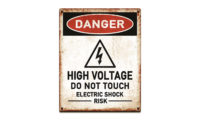Safety lessons from California warehouse fires

California has had its fair share of fires over the years, especially the wild variety. This year’s wildfires have already burned more than 1 million acres, and nearly a dozen are still ablaze. Now, the Golden State is facing an uptick in warehouse fires in some of its biggest and most populated cities, including Oakland, Carson and El Sereno.
Most — if not all — of these incidents could have been prevented if residents, city officials, inspectors and landlords had practiced proper safety protocol. Instead, they neglected to follow building codes and threw caution to the wind. Subsequently, many people sustained injuries and dozens more perished in these devastating warehouse fires.
Warehouse managers, inspectors and safety supervisors have much to learn from these tragedies to prevent similar disasters in the future.
1. Proper storage techniques are critical
Los Angeles city and county firefighters fought a warehouse fire in Carson Thursday, Sept. 30. The county fire inspector said the blaze spread among rubbing alcohol wipes stored in crates and pallets within the facility. However, their teams couldn’t do much to stop the flames because the containers were piled high and presented a serious fall hazard. If warehouse workers had properly arranged the boxes, the firefighters might have been able to put the flames out sooner.
2. Frequent inspections ensure safety
In addition to practicing proper storage techniques, workers could have maintained a smaller inventory to avoid stacking crates of flammable materials. In the future, warehouse managers can use Internet of Things sensors to better manage the supply chain and organize stock.
The El Sereno fire, which occurred the same day, also housed flammable products like furniture and interior design items, which quickly caught ablaze and added fuel to the flames. Building inspectors could have reduced the risk of a fire by conducting more frequent inspections. In the future, these precautions can help to determine potential hazards and advise against overstocking, especially regarding combustible supplies and equipment.
3. Buildings must have fire escape routes
Inspections may have prevented the historically devastating Ghost Ship warehouse fire in Oakland, too. This incident, which killed 36 people, occurred in 2016 in a building that hadn’t been inspected in 30 years. While the cause of the fire is still unknown, investigators know there were no smoke detectors or fire alarms in the building that had been converted to a residential facility.
Derick Almena, the building’s master tenant, had built two makeshift staircases up to the second floor. Neither one led to an exit and, by the time the upstairs occupants realized there was a fire, it was too late to escape. Therefore, inspectors must assess fire escapes and ensure stairwells and exits are up to code. Otherwise, a similar tragedy could easily happen again.
4. Illegal interior construction is hazardous
Illegal interior construction can be hazardous and even deadly. Almena, who built the illegal staircases, also used pianos, couches, beds, wood and fabric partitions to close off workspaces and house the two dozen people who lived there. In a traditional building, these materials would have failed flammability tests and the structure would be deemed unsafe for living and working.
These illegal conversions were a death sentence to those who attended the electronic music and dance party on Dec. 2. However, OSHA inspectors, landlords, property managers and builders can prevent such tragedies in the future by abiding by building codes during construction and subsequent renovations.
5. Electrical wiring must meet codes
The Ghost Ship’s master tenant also outfitted the two-story warehouse with extension cords instead of hiring an electrician to rewire the building. A spider web of breaker boxes, transformers and power cords likely sealed residents’ fate. However, it’s clear Almena was aware of potential electrical hazards as the building was also home to a transformer fire two years prior. Ben Cannon, an unlicensed contractor, even described “grossly unsafe” conditions in the years leading up to the Ghost Shop blaze.
Overloading electrical panels and transformers, failing to ground breaker boxes and deferred maintenance can have serious consequences. Electrical wiring must meet all local codes and pass inspections to be deemed safe for habitation or work.
Learning from the past
Philosopher George Santayana once said those who cannot learn from history are doomed to repeat it. Therefore, property managers, inspectors and industrial safety supervisors must learn from these California warehouse fires and do everything in their power to prevent future tragedies.
Looking for a reprint of this article?
From high-res PDFs to custom plaques, order your copy today!








